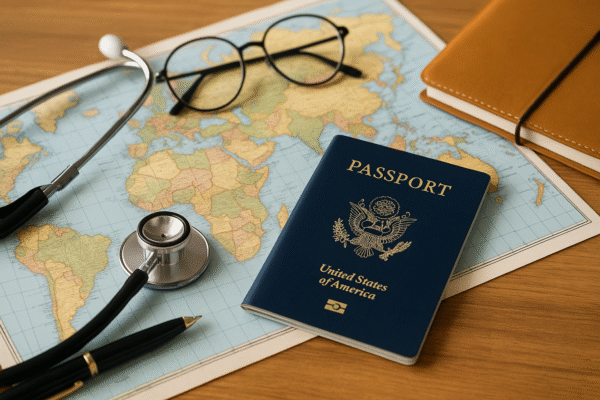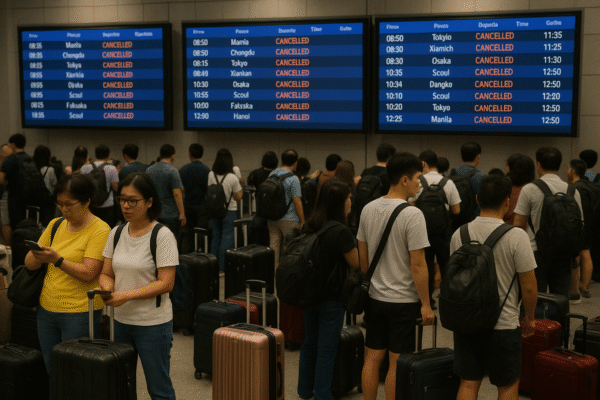Severe tropical weather systems sweeping across East and Southeast Asia have grounded hundreds of flights, creating widespread travel disruption from China to the Philippines and Vietnam. Major international carriers including Singapore Airlines, Cathay Pacific, Japan Airlines (JAL), Air India, and Air China have collectively canceled or delayed hundreds of flights, as typhoon warnings, torrential rain, and strong winds paralyze aviation hubs in the region.
Airports in key cities like Beijing, Hong Kong, Tokyo, Hanoi, and Manila are among the worst-hit, as heavy rainfall—up to 20 inches in parts of the Tokyo region—has prompted operational chaos, leaving tens of thousands of passengers stranded or rerouted.
Beijing Capital Airport Faces Widespread Disruption
Beijing Capital International Airport, China’s busiest and one of Asia’s largest aviation centers, reported 397 delays and 29 flight cancellations as of Monday morning. Air China, the airport’s dominant carrier, accounted for 253 delayed flights, with China Eastern Airlines also impacted.
Passengers traveling on domestic routes to Shanghai, Guangzhou, and Chengdu, as well as international services to Tokyo, Bangkok, and Manila, were forced into long queues as rebooking options dwindled. Government advisories issued by the Civil Aviation Administration of China (CAAC) urged travelers to monitor updates closely and expect operational delays through midweek.
Incheon International Battles Backlogs
Incheon International Airport in South Korea logged 188 delays and six cancellations, affecting carriers such as Korean Air, Air Seoul, and Air Incheon. While cancellations were relatively limited, the knock-on effect on connecting flights across Asia caused frustration among transit passengers. Korean Air alone saw 44 delayed flights, many of which were bound for typhoon-hit cities in China and Japan.
Cathay Pacific and Hong Kong Flights Snarled by Storms
In Hong Kong, 215 flight delays were reported at Hong Kong International Airport, with Cathay Pacific logging 75 of them. Although no outright cancellations were reported, officials at the Hong Kong Observatory warned of continued heavy rains and gusts through the next 48 hours, urging passengers to avoid non-essential travel. Cathay Pacific’s flexible rebooking policy has been extended, allowing affected passengers to change travel dates at no extra cost.
Tokyo’s Haneda Airport Delays Surge
In Tokyo, Haneda Airport experienced 209 delays, with ANA Wings, Japan Airlines, and Air France impacted. Although no cancellations have been announced, the Japan Meteorological Agency has maintained typhoon alerts, with localized flooding reported in parts of the Kanto region. Authorities warned that rail and bus connections from airports to city centers may also be affected by storm-related closures.
Widespread Disruption in Southeast Asia
Airports across Southeast Asia—particularly Kuala Lumpur, Bangkok, and Manila—also reported significant disruptions.
- Kuala Lumpur International Airport saw 255 delays and 4 cancellations, with AirAsia taking the brunt. The carrier reported 138 delayed flights, causing a ripple effect throughout its vast regional network.
- Bangkok Suvarnabhumi Airport logged 83 delays and 5 cancellations, affecting services by Thai Airways, Nok Air, and Air India Express.
- In the Philippines, Manila Ninoy Aquino International Airport (NAIA) saw multiple delays as PAGASA (Philippine Atmospheric, Geophysical and Astronomical Services Administration) issued typhoon bulletins warning of strong coastal winds and high waves.
Vietnam’s Noi Bai International Airport in Hanoi also reported a backlog of delayed domestic and regional flights. Local carriers such as Vietnam Airlines and Bamboo Airways were among those forced to ground operations due to unsafe flying conditions.
Airlines Implement Emergency Measures Amid Chaos
Major airlines have activated emergency response measures to deal with mounting passenger dissatisfaction.
- Singapore Airlines and Cathay Pacific have introduced fee waivers and flexible rebooking options.
- Korean Air, AirAsia, and JAL have dispatched extra ground staff and extended hotline hours to accommodate passenger inquiries.
- Social media platforms, particularly X (formerly Twitter) and Weibo, have become real-time complaint centers, with travelers posting images of overcrowded terminals, blank departure boards, and scarce rebooking kiosks.
Despite best efforts, airport helplines remain overwhelmed, with many passengers experiencing multi-hour waits for support. Airlines and airport authorities are urging travelers to check official apps and government weather services before leaving for the airport.
China and Regional Airports Brace for More Weather
According to the China Meteorological Administration (CMA), several typhoons are expected to affect eastern and southern China through early August. Shanghai Pudong International Airport reported 275 delays and cancellations combined, with weather conditions expected to worsen later this week.
Flight operations in Chengdu, Shenzhen, and Guangzhou are also at risk as tropical weather systems move inland. The ASEAN Centre for Meteorology has cautioned that storm surges and flooding may continue to cause transportation disruptions regionwide.
Outlook: Summer Travel Turmoil Likely to Persist
The aviation sector across Asia remains on high alert as meteorological agencies predict further instability. With the peak summer travel season in full swing, the risk of further flight cancellations and overcrowding remains high. Airlines, airport authorities, and regional governments are coordinating closely, but operational recovery is expected to be gradual.
Travelers are advised to plan alternate routes, monitor official flight notifications, and avoid tight layovers when booking connections across storm-prone cities.
For more travel news like this, keep reading Global Travel Wire


















